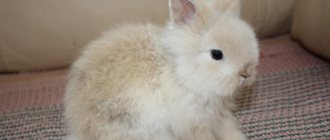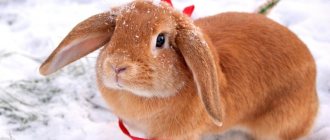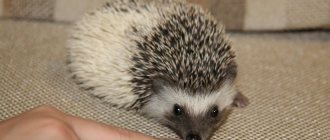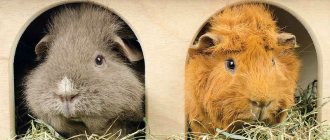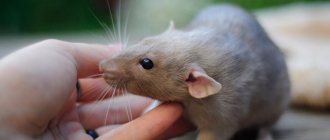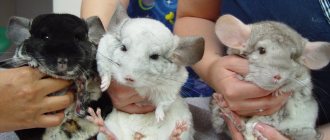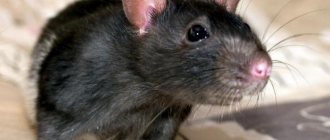Breeders who want to acquire a decorative pet often choose the Dwarf Fold Ram rabbit breed. These animals are less whimsical than other representatives of domestic dwarf breeds. They have some distinctive features and standards, according to which they must be selected for purchase, participation in exhibitions and breeding for sale. The animals have a friendly disposition and can be kept in normal apartment conditions. Meanwhile, for easier maintenance and breeding, it is important to know about some nuances. This article will tell you how to select rabbits, feed them properly and care for them.
Origin
Charles Darwin mentioned lop-eared rabbits in his treatises. He noted that if healthy rabbits with erect ears gave birth to animals with drooping ears, this anomaly persists in subsequent generations.
The English lop-eared rabbit Ram is the oldest representative of this species . They were first introduced in 1890, and in 1908 the breed was officially registered with the International Hermelin Breeders Club. Rabbits got their name from the unusual shape of their muzzle, reminiscent of a ram. At the same time, breeding work on animals was continued and in the mid-twentieth century, the fold-eared dwarf breed of Ram rabbits was bred. It quickly spread throughout the world and today has ceased to be a rarity in Russia. Also read about the Loman Brown chicken breed here.
The first mention of rabbits came from England
Temperament
In general, decorative dwarf rabbits are very friendly and calm. However, sometimes among them there are real fidgets. Communication with them is reminiscent of communication with small children - they are inquisitive, playful, affectionate and childishly naive. Rams love independence.
Give your pet the opportunity to walk around the apartment on his own more often, but still keep an eye on him so that the rabbit does not accidentally get injured. If you pick up a small ram, it will immediately try to climb onto your back, as if demonstrating who is boss.
Description of the breed
Like any noble breed of rabbit (California, New Zealand, Rex), the Ram has its own standards. The characteristics of this particular dwarf breed are as follows:
- body weight - 1-2 kilograms , with an ideal exhibition weight of one and a half to two kilograms;
- body length - up to thirty centimeters;
- strong muscular body in the form of an elongated cylinder;
- small tail, close to the body;
- massive large head , wide forehead;
- lack of dewlap in female rabbits;
- large, round eyes;
- smooth fur, hair length up to eighteen millimeters;
- short powerful legs.
The colors of rabbits are: ocher, gray, dark gray, white, black and chocolate. Rabbits for subsequent keeping and breeding should be selected directly according to the above standards. You can find out about the Wyandotte chicken breed at this link.
Rabbit breed "Lop-eared dwarf ram"
There are many varieties of dwarf fold-eared Rams. The most common ones are:
- Lion-headed dwarf Ram. The variety got its name from its mane up to twenty-five centimeters long.
- Fox Ram. It is distinguished by its high cost and rounded head shape.
- Dutch Fold. It has several additional subspecies.
- Angora dwarf Ram . The bodies of the animals are covered with soft downy hair.
- Dwarf Rex Ram . Has short wavy hair.
Angora Dwarf Ram
Up to two and a half months, the ears of the young are directed upward and this does not mean the presence of a defect. Later they gradually begin to descend.
Selection rules
If you nevertheless decide to have such a baby at home, in order to be sure to purchase a purebred representative of the breed, when purchasing it, you should pay attention to some of the features that distinguish real dwarf rams.
Signs of purebredness
The health and purity of a rabbit is indicated by:
- Animal fur. It should be shiny, thick, smell nice, and evenly cover the entire body of the animal.
- Eyes. They should not be inflamed, watery, or have crusts on them.
- Ears. The hearing organs of dwarf ram rabbits should be between 24 and 28 cm in size.
- Teeth should be straight and white.
- The entire body of a healthy, purebred rabbit should be elastic, muscular, strong and proportional.
Important! Remember that it is better to buy a dwarf ram in certified pet stores, where all the necessary veterinary certificates about the animal’s health are attached to the animal.
Signs of culling
If you notice one or more of the following signs in a rabbit that you are offered to buy, then it is better to refrain from the transaction:
- The animal's fur has bald spots, is dull and has an unpleasant odor.
- The little animal's eyes look inflamed, they are red and watery.
- The ears of an adult stick up or are much shorter or longer than normal.
- The rodent's teeth grow in uneven rows, are partially absent or significantly affected by plaque.
- The rabbit looks sick, does not want to make contact with people and looks very scared.
Breed productivity
High productivity and opportunities for earning income from the sale of meat and fur are present in ordinary rabbits of the Ram and Black-brown breeds. The dwarf is most often bred as decorative pets. However, you can earn income by breeding for sale. In this case, it is necessary to purchase animals that meet the standards in order to obtain high-quality litter. Also read about bare-necked chickens here.
Female rabbits have an average degree of fertility. So, two or three litters are produced per year. For each litter, females bring five to eight young rabbits. Also read about dwarf chickens.
Female rabbits have an average degree of fertility
Productive qualities
Dwarf female ram rabbits can easily produce offspring starting from the age of six months. With proper care, the female herself, without outside help, is able to give birth to 5-7 rabbits and feed them with her milk for quite a long time.
The main condition for this is the cleanliness of the cage, a sufficient amount of clean drinking water, regular feeding and the absence of irritating factors.
Maintenance and care
It is recommended to raise young and adult rabbits in large cages for free movement. It is important that they have a special tray for quick cleaning, as well as a compartment for feeding, sleeping and toileting. Inside, sawdust filler, hay or straw can be used as bedding. It will need to be changed every two to three days, followed by washing the cage. Disinfection with caustic soda should be carried out once or twice a week. This article will tell you about the features of keeping chickens of the Faverol breed.
It is recommended to keep Ram rabbits in large cages
The cage should be installed as far as possible from radiators and drafts. Avoid high humidity and direct sunlight. Feeders and drinkers must be installed in the cage. It is also recommended to purchase several specialized toys from a pet store. Also read about the Paduan chicken breed.
The appearance of animals also needs to be monitored. To do this, it is advisable to purchase a special nail clipper and a wool brush. Bathing rabbits is not recommended. It is enough to clean out pellets, debris and dead hairs from the fur. You can learn about the Xin Xin Dian chicken breed from this material.
Rabbits must be brushed regularly with a special brush.
It is not recommended to use a mesh cage floor. This can be fraught with mechanical damage to the limbs.
How to train an animal
Smaller rabbits by nature have increased caution, so the owner is not accepted immediately. When caring for it, try to scare the big-eared cat as little as possible and never force it out of the house. He will hide in the farthest corner and will watch your actions with caution. Instead, just open the cage slightly and wait a little; as a result, the baby’s curiosity will prevail over his fears and first his muzzle and ears will appear in the open opening, followed by the animal itself.
Always approach the cage with a calm, measured step, and do not swing or move your arms sharply. Try to arouse your pet's interest in a tasty treat while he is eating, talk to him quietly, almost in a whisper, and most importantly, kindly and friendly.
If you notice that your pet is being overly aggressive, gently press him to the floor with one hand. This way he will feel his dependence on you and slow down a little. The thing is that in nature, in order to win, a rabbit needs to jump on the back of its opponent; the one who does this first is the leader and is usually obeyed. If you are not sure that you can properly overcome the aggression of rams, you can watch video instructions on this topic on the Internet.
Feeding
For lop-eared dwarf rabbits, hay is the main source of nutrition in winter, and dried greens in summer. These foods contain large amounts of essential protein and carbohydrates, as well as vitamins and minerals. In addition, the diet must include:
- grain mixtures and cereals (preferably specialized);
- vegetables, seasonal fruits and root vegetables (washed, peeled, fresh or boiled);
- combined mixtures and mash.
It is recommended to limit the presence of legumes, cabbage and dairy products in the diet. In abundance, they can worsen digestion and cause dysbiosis. Animals must be fed twice a day. The daily food intake is twenty to thirty grams of food per head.
In winter, the diet of lop-eared rabbits is based on hay.
Solid and hard food, as well as branches of fruit and coniferous trees, must be present in the cages at all times. They are necessary for the systematic grinding of rabbits' teeth.
Reviews
We once had a pet like this. A very cute animal, and, most importantly, not stupid. There were no problems with the smell in the apartment, because it went into the tray, and we regularly changed the litter. By the way, we used ordinary wood. The same one we give to the cat. By the way, about the cat. When the rabbit went for a walk, the cat kept chasing him. He didn’t bite or scratch, but sometimes he tried to touch him with his paw. I read somewhere that this was not good, and then we separated them into different rooms. Elizaveta, 37 years old, St. Petersburg
My daughter has been begging for a furry animal for a long time. We took the plunge and chose a representative of the fold-eared breed. The animal is very interesting. Or rather, it’s interesting to watch him. Now I have been rabbiting for 3 years. He and his daughter are best friends. Veronica, 33 years old, Moscow region.
I’ll tell you our story of communication with such wonderful animals. Friends were moving to live in another country and offered to take the rabbit from them. We were not eager to have another pet (we already have a cat and a parrot), but the child saw enough about decorative rabbits on the Internet and persuaded us to adopt him. As a result, the rabbit lived with us for about 2 years (at the time we adopted him, he was over 4). The animal is cute, but we were unable to establish contact with it as such and categorically refused to go into our arms. This is probably because I found myself in different conditions as an adult. Vasily, 40 years old, Krasnoyarsk
Breeding
For breeding, it is necessary to purchase purebred animals only from specialized enterprises or from friends. When purchasing, you need to pay attention to the compliance of young animals with standards. In addition, it is recommended to examine the appearance of the animals, namely the eyes and nose - they must be clean. It is better to avoid purchasing individuals with plucked fur and lack of activity and vigor.
When purchasing a rabbit, you must carefully inspect the animal for compliance with standards.
Females and males are fully ready for mating by the age of eight months. If signs of anxiety are detected, animals should be placed in a separate cage for up to one week. The results of mating can be found out after two weeks by examining and palpating the rabbit’s abdomen. The gestation period for rabbits is thirty days.
The mother rabbit's sudden anxiety can also indicate her readiness to give birth. She becomes more nervous and begins to build a nest from litter and her own fur. As a rule, this period begins one week before the birth.
Rabbits should be kept in the same cage with their mother for the first month of life. Up to two and a half months they can be fed with dairy products even after weaning.
Keeping Your Minilop Healthy
Keep the cage clean.
A rabbit's hutch needs to be cleaned every week. Let the rabbit stay with your friend until you have thoroughly cleaned the cage. Throw away old newspapers and hay, wash the cage with soapy water, dry it and fill the cage with clean newspapers and hay.
- Rinse the food bowl and water bottle every couple of days.
- Replace the tray liner every day.
Brush your Minilop's fur.
Rabbits do not like to bathe as they groom themselves on their own. However, they do like a little brushing. Use a soft-bristled brush to occasionally care for your rabbit's fur. Minilops shed as adults; during shedding, you can help remove excess rabbit hair with a wire brush.
- If your rabbit gets dirty in the yard, you can give him a bath with rabbit shampoo. Never use human shampoo on your rabbit.
- If you notice that your rabbit's nails have grown too long, you can trim them.
Have your rabbit checked regularly by a veterinarian.
You may have difficulty finding a veterinarian who can examine your rabbit, as some veterinarians specialize only in cats and dogs. Look for an exotic animal veterinarian if your local veterinarian is not an expert in this field. Get checked annually or whenever you notice symptoms of the following:
- Running nose or eyes
- Refusal to eat
- Red urine
- Heat
- Diarrhea
- The head is constantly tilted
- Lumps or boils under the fur
conclusions
- The Dwarf Ram is a variety of the Fold Ram breed and is used as an ornamental.
- The breed has standards for participation in exhibitions.
- Nutritional standards must be observed , otherwise indigestion or illness may occur.
- You can benefit from breeding and keeping dwarf Rams by selling them.
- to purchase animals for breeding and restocking only from specialized farms.
Character of the Lop-eared ram
Lop-eared rabbit The dwarf ram is popular due to not only its miniature size, but also its sweet, calm and friendly character. They quickly get used to people and love to spend time with children, playing active games with them. This makes the dwarf rabbit an ideal pet for families with children.
At first, when getting used to the family, the Dwarf Ram rabbits behave a little shy and wary, but quickly adapt. They explore new territory with great curiosity and inquisitiveness. In terms of loyalty and affection for its owner, the small Lop-eared ram resembles a dog.
Fold rabbits are very sensitive and responsive to human affection. They require regular communication with a person. When alone, the pet begins to get bored, become depressed, and become cowardly and wild. Despite its toy appearance and tiny size, the Lop-Eared Ram knows how to stand up for itself in the event of approaching danger, painfully biting its offenders.
IMPORTANT! How long do furry animals live? The life expectancy of a rabbit depends on the conditions of its keeping. On average, fold-eared breeds live up to 7 years; with good maintenance and careful care, a rabbit will live up to 10 years.

